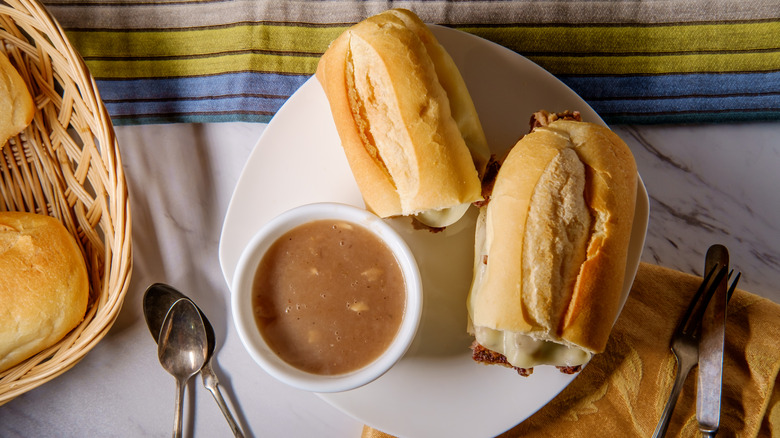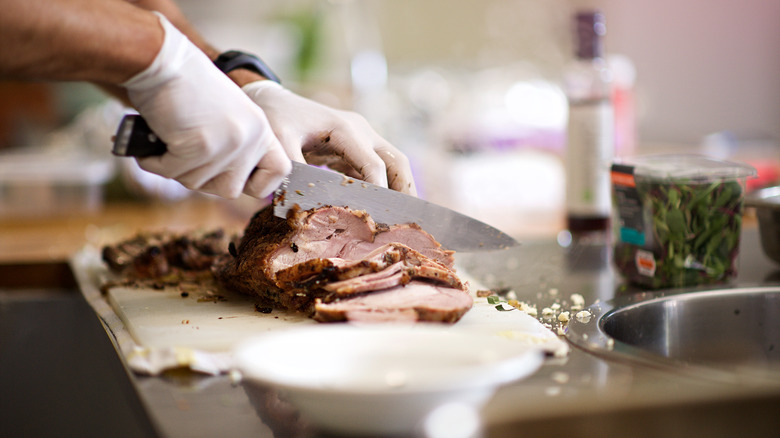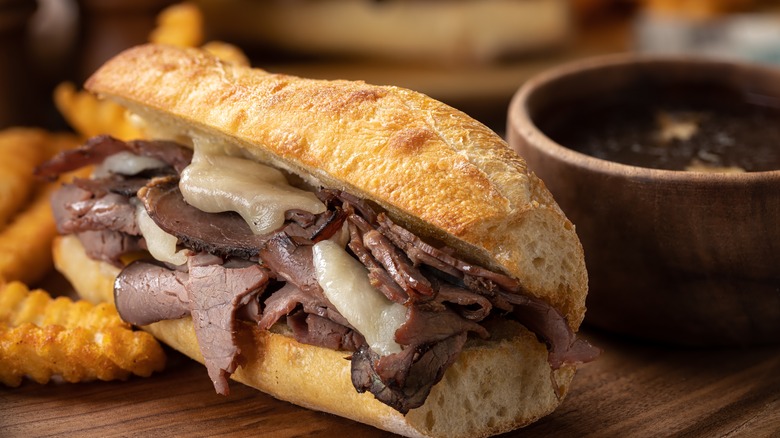Chicago's Gravy Bread Is Exactly What It Sounds Like
It's clear to see why so many foodies flock to Chicago. The city is famous for its veggie-loaded hot dogs, offers strong contenders in both the deep dish and thin crust pizza categories, and on the fine dining side, it's home to an impressive roster of Michelin-starred restaurants. While many local specialties easily win the hearts of natives and tourists alike, some traditional fare — like gravy bread — is under-appreciated and takes some time to warm up to.
This dish can be described as a stripped-down version of the city's beloved Italian beef sandwich: Just take out the beef and pickled vegetables, leaving nothing but a plain Italian roll fully saturated in a beef gravy (aka jus) that has become a time-honored tradition. Made from beef bouillon, a blend of herbs and spices unique to each establishment, and the flavorful drippings of the beef cooked inside it, you don't have to wonder why a dish like this one became popular.
For those with strong aversions to soggy food, gravy bread probably won't land on your list of Chicago delicacies to try. But if gravy is your favorite part of Thanksgiving, and you love a deeply savory, rich beef version even more than beef itself, you're gonna want to try it.
The origins of gravy bread
Before gravy bread, there was the Italian beef sandwich. Following World War I, Chicago's Italian immigrant population exceeded both those in New York City and Philadelphia. Although a sizable population, many Italians coming to America were poor peasants looking for better professional opportunities. They faced great prejudice in Chicago, which kept them from securing stable housing or employment.
Many Italians worked in stockyards. The work was hard, but workers got discounts on less desirable slabs of meat. Tough cuts of beef benefit from slow cooking, so the immigrants could produce flavorful fare that could feed large families inexpensively — especially as a sandwich filling. Anthony Ferarri is often credited as the official inventor of the Italian beef sandwich we know today (though this history is heavily debated). Instead of typical thick-cut roasts, he filled an Italian roll with finely sliced roast beef cooked in a well-seasoned gravy, topped with pickled giardiniera. In 1938, Albert Ferarri opened Al's Bar B-Q using this recipe, and by the end of World War II, many others were selling Italian beef sandwiches.
Today, the Italian beef sandwich is a quintessential Chicago meal, and you specify your desired level of juiciness by ordering dry, wet, or dipped. But according to old-school Chicagoans, to appropriately appreciate a restaurant's signature gravy, gravy bread is the way to go. All fillings are omitted, and the bread is submerged in meat sauce until its structural integrity diminishes; then your gravy bread is ready to eat.
Chicago isn't alone in loving gravy-soaked bread
While there's no shortage of gravy bread slander on the internet — it seems people are as sensitive to the word soggy as they are "moist" — it makes sense that this dish has won over many people's hearts. Each restaurant has a unique recipe for preparing Italian beef and the flavorful sauce in which it's simmered — a recipe that's often honed over decades and passed down from one generation to the next. Gravy bread allows customers to appreciate the full flavor profile without other ingredients clouding their palate.
Although Chicago's open love of gravy-soaked carbs is sometimes misunderstood, plenty of other cuisines do something similar. Think of biscuits and gravy, Philly cheesesteak with a classic au jus, California's French dip sandwiches, or even Appalachian gravy bread. Whether commonly revered or rejected, each variation pairs these two components to create a flavorful, filling, and nourishing dish with rich historical significance.
So next time you're in Chicago, consider trying gravy bread –- you can order it at an institution like Portillo's, or almost anywhere else that sells Italian beef. And if gravy and bread alone doesn't appeal to you, order peppers inside for an elevated, yet perfectly authentic gravy bread variation.



